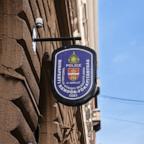How a university is using AI to reduce cafeteria food waste
Food waste is a massive problem. According to the UN, the world wastes more than a billion tons annually. Here at home, Americans waste around 80 million tons each year. And worldwide, nearly 40% of all the food we produce is lost or wasted, according to the WWF.
At the same time, Feeding America, a nationwide network of food banks and pantries, says 47 million people in the U.S. face hunger, including 1 in 5 children. Then, there are the significant environmental impacts of sending so much wasted food to landfills. Left to decompose, this organic waste releases methane, a powerful greenhouse gas that's far more potent than carbon dioxide.
How AI is being used to tackle food waste
Erin Murphy, a student at Georgia State University in Atlanta and a sustainability initiatives intern, saw all the food her peers were wasting and wanted to do something about it. She applied for a grant to bring new technology to campus that uses artificial intelligence to examine food waste and provide real-time data on what's left behind.
The technology, aptly named "Raccoon Eyes," analyzes the food left on each plate, categorizing and weighing the leftovers to provide detailed data on the waste and recommendations for reducing the leftovers.
When students finish their meals, they place their plates on a conveyor belt, where "Raccoon Eyes" captures an image of the plate. AI then uses that picture to evaluate the contents. This data is displayed on an online dashboard, offering real-time insights to the dining staff.
Ivan Zou, the co-founder of "Raccoon Eyes," said the information helps identify trends, such as how many plates of a specific meal were uneaten. For example, the system showed that students ate most of the salmon they put on their plates during a particular meal, but they left behind a lot of French fries during another meal.
Jennifer Wilson, GSU's director of sustainability, said that since the program's launch in January, AI has analyzed over 400,000 plates and found that approximately 21% contained food waste.
And it turns out that some of the most popular items, like chicken, pizza, and french fries, also generate the most waste. The dashboard's detailed feedback, however, also reveals that popular meals often have leftover portions because students take too much, not because the food is unpopular. This nuanced insight helps dining services adjust not only the menu but also portion sizes and serving methods.
The initiative is already making a difference. In the first four months, GSU reduced food waste by 23%, thanks to AI insights and increased student awareness.
The program even encourages feedback through a kiosk where students can leave comments like "sorry for my waste." Such feedback has proven invaluable, guiding the dining team in refining their offerings, for instance, by making more of the crowd-favorite Hot Cheetos sushi and less of other items.
-ABC News Climate Unit's Matthew Glasser, ABC News' Matt German, and ABC News meteorologist Dan Manzo







